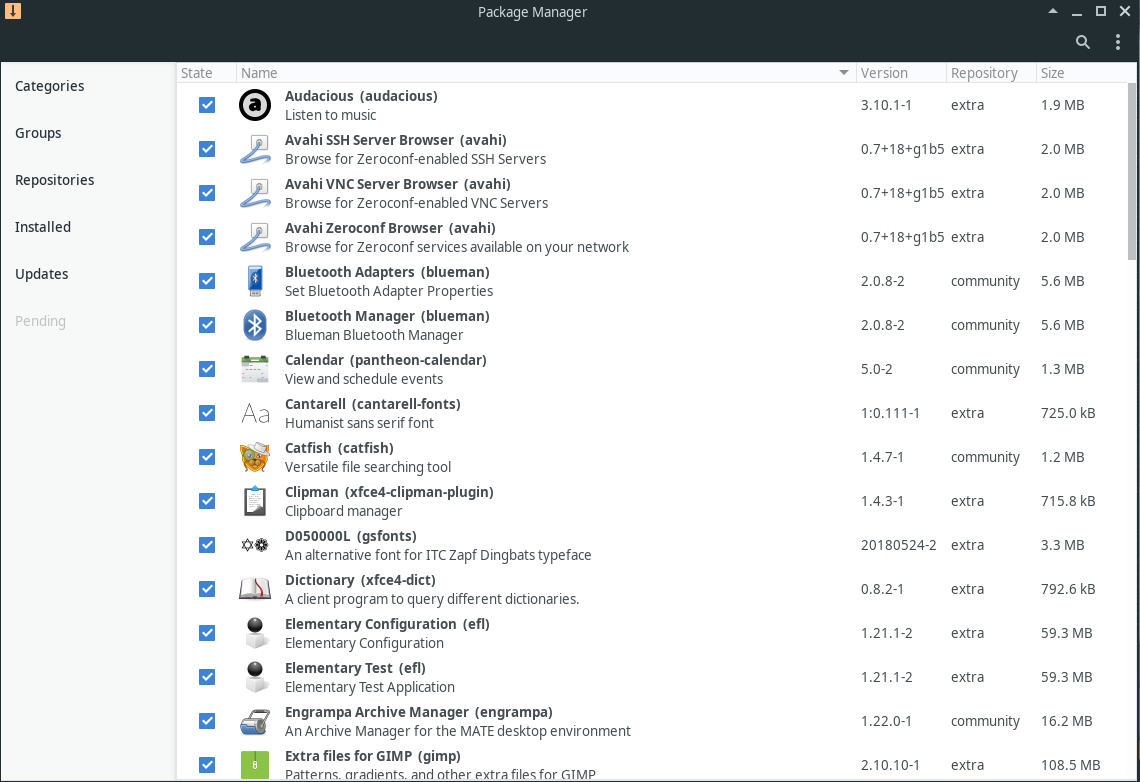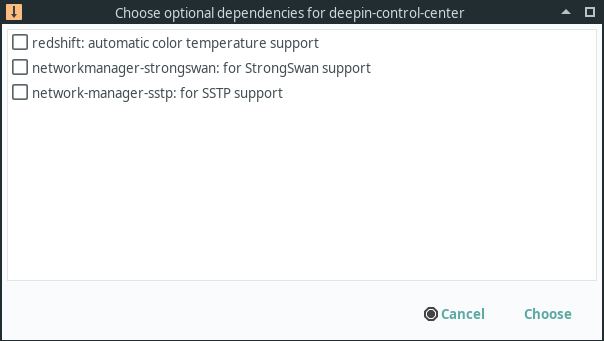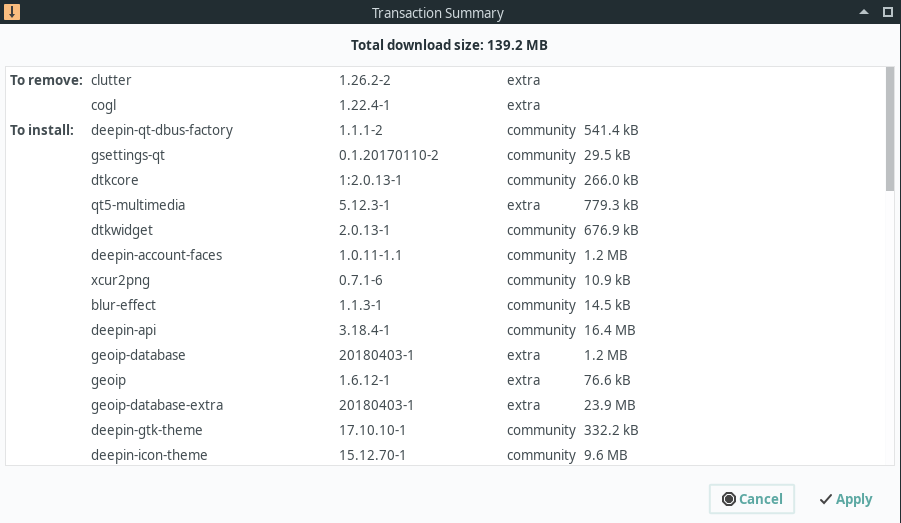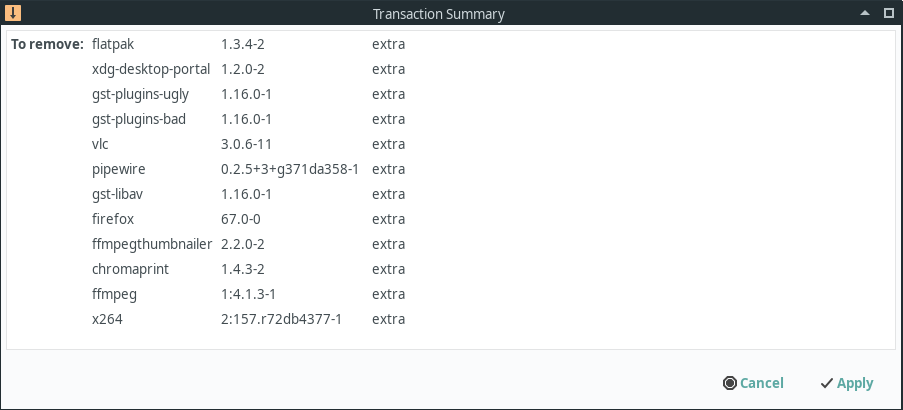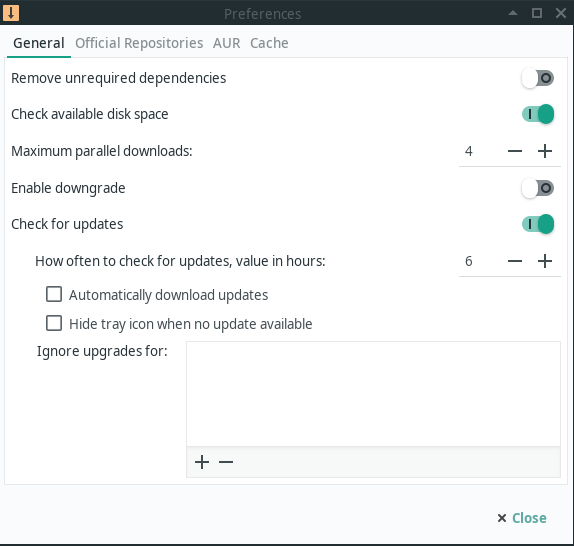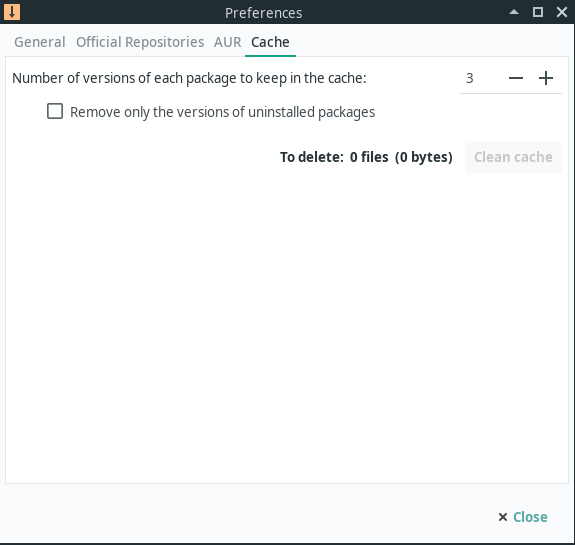پَمَک (Pamac)
Views
Actions
Namespaces
Variants
Tools
نمای کلّی
پَمَک (Add/Remove Software) مدیر بسته نگارهای مانجارو است. این بر اساس libalpm با پشتیبانی از مخزن کاربر آرچ (AUR) و Appstream است. این بر روی ارائه یک رابط کاربری آسان تمرکز دارد در حالی که هنوز مجموعه ای قدرتمند از ویژگی ها را ارائه می دهد.
نصب کردن پَمَک
پَمَک روی بسیاری از نسخه های مانجارو از پیش نصب شده است، اما اگر سامانه شما آن را نداشته باشد، می توان آن را به راحتی نصب کرد. پَمَک در چندین بسته مختلف عرضه می شود:
pamac-gtk- نسخه GTK از پَمَک. شامل یک نماد سینی برای بسیاری از میزکار ها است.pamac-cliنسخه خط فرمانیِ پَمَک.pamac-tray-icon-plasmaیک نماد سینی برای KDE plasma.
این بسته ها را می توان با استفاده از پَکمَن (Pacman) نصب کرد. به عنوان مثال، برای نصب نسخه GTK، می توانید از دستور زیر استفاده کنید:
sudo pacman -Syu pamac-gtk
با استفاده از رابط کاربری نگارهای (گرافیکی) پَمَک
نصب کردن نرمافزار
برای نصب بسته ها کافی است کادر کنار بسته ها را علامت بزنید. پس از انتخاب تمام بسته ها (تمام بسته هایی که می خواهید نصب کنید) روی دکمه Apply در پایین صفحه کلیک کنید.
اگر هر یک از بستهها وابستگیهای اختیاری داشته باشند (بستههایی که قابلیتهای اضافی را فعال میکنند)، پنجرهای مانند تصویر سمت چپ مشاهده خواهید کرد که به شما امکان میدهد بستههایی را که میخواهید نصب کنید انتخاب کنید.
بعد از اینکه وابستگی های اختیاری را انتخاب کردید، باید پنجره ای شبیه به تصویر سمت چپ ببینید. این فهرست تمام بسته هایی را که با این عمل نصب، ارتقا یا حذف خواهند شد، فهرست می کند. پس از بررسی فهرست، دکمه Apply را فشار دهید تا بسته ها نصب شوند.
ممکن است متوجه شوید که این لیست بسته های بیشتری نسبت به آنچه در رابط کاربری گرافیکی انتخاب کرده اید دارد. این به این دلیل است که بسیاری از بسته ها دارای وابستگی هایی هستند که بسته هایی هستند که باید نصب شوند تا نرم افزار انتخابی شما به درستی کار کند. همچنین ممکن است متوجه شوید که بسته ها در حال حذف شدن هستند، حتی اگر هیچ بسته ای را برای حذف انتخاب نکرده باشید. این در مثال سمت چپ اتفاق میافتد، جایی که میتوانید ببینید که clutter و cogl حذف میشوند. آنها حذف می شوند زیرا با deepin-clutter و deepin-cogl که عملکرد یکسانی را ارائه می دهند در تضاد هستند.
حذف کردن نرمافزار
حذف نرمافزار به سادگی برداشتن تیک بستههایی است که می خواهید حذف کنید و روی دکمه Apply در پایین صفحه کلیک کنید.
هنگامی که این کار را انجام دادید، باید صفحهای مشابه صفحه سمت چپ ببینید که تمام بستههایی را که قرار است حذف شوند، فهرست میکند. ممکن است متوجه شوید که این لیست حاوی بستههای بیشتری از آنچه شما انتخاب کردهاید است. این به این دلیل است که وقتی بستهای را حذف میکنید که سایر بستهها به آن وابسته هستند، آن بستهها نیز حذف میشوند.
Preferences
You can access the preferences by clicking on the three dots in the upper right corner and selecting preferences.
The General tab of preferences contains several settings, most of which are self explanatory.
- Remove unrequired dependencies - This removes dependencies which are no longer required by any package
- Check available disk space - Checks to ensure you have sufficient disk space available before downloading and installing packages
- Maximum parallel downloads - The number of concurrent downloads allowed
- Enable downgrade - This allows packages to be downgraded as well as upgraded. This is important when switching branches.
- Check for updates - Disabling this will stop Pamac from looking for updates. In most cases, turning this off on a rolling release distro like Manjaro is a bad idea.
- Ignore updates for - This is a list of packages that you don't want to be upgraded. This is inherently dangerous practice and should only be used by advanced users.
Pamac is also capable of using scripts from the Arch User Repository(AUR) to install or update packages. Please carefully read the considerations in the linked page prior to enabling support for AUR.
If you enable AUR support, you may also select, "Check for updates from AUR" so software you install from AUR won't become outdated. An alternative is creating an account on AURweb and subscribe to notifications for the scripts you are using on a permanent basis.
Checking for "development package" updates will allow updates on *-git packages which are built from the latest source code to also be updated.
The "Build directory" is where AUR packages will be built. Using "tmp" usually will provide the best performance but very large packages may fail to build. In this case, select somewhere with more available space.
When Pamac installs packages, it keeps a copy of all the old packages you have downloaded. This cache can be very useful if you have to download packages in an emergency. However, left unchecked, this cache will grow very large over time. These preferences allow your cache to be automatically managed based on your preferences.
The first option allows you to set a number for how many copies of each package are retained. In other words, if you have downloaded 25 versions of firefox over the life of your install and you set this number to "3", only the most recent 3 versions will be retained. Unless you are very short on disk space, it is recommended to set this to at least 2.
By selecting "Remove only the versions of uninstalled packages" pamac will retain all versions of packages you still have installed.
Using the Pamac CLI
Pamac also includes a fully functional CLI for when you don't have a functional GUI or for those that prefer to manager packages that way.
Locating and Installing Packages
To search for available packages you can use the command pamac search. For example, to search the repos for packages containing the word smplayer:
pamac search smplayer smplayer [Installed] 19.5.0-1 community Media player with built-in codecs that can play virtually all video and audio formats smplayer-skins [Installed] 1:15.2.0-2 community Skins for SMPlayer smplayer-themes [Installed] 1:18.6.0-1 community Themes for SMPlayer
As you can see, this will also show you which packages are already installed. If you would like to search both the repos and AUR you add -a like this:
pamac search -a smplayer smplayer [Installed] 19.5.0-1 community Media player with built-in codecs that can play virtually all video and audio formats smplayer-skins [Installed] 1:15.2.0-2 community Skins for SMPlayer smplayer-themes [Installed] 1:18.6.0-1 community Themes for SMPlayer papirus-smplayer-theme-git 20181024-2 AUR Papirus theme for SMPlayer (git version) smplayer-svn 17.12.0.r8852-1 AUR Advanced front-end for MPlayer/MPV smplayer-svn-notitlebar 18.3.0.r8982M-1 AUR Advanced front-end for MPlayer/MPV + Patch to disable titlebar in compact mode smplayer-skins-svn 15.2.0.r8852-1 AUR Skins for SMPlayer smplayer-themes-svn 17.3.0.r8852-1 AUR Themes for SMPlayer smplayer-qt4 18.5.0-1 AUR Complete front-end for MPlayer/MPV (Qt4) rosa-media-player-plugin 1.0-2 AUR The new multimedia player(based on SMPlayer) with clean and elegant UI (mozilla plugin only). smplayer-theme-faenza (Out of Date: 09/15/2017) 2-2 AUR Normal, dark and silver faenza theme for smplayer. umplayer 0.98.2-2 AUR An alternative to SMPlayer
Once you have identified the packages you wish to install you can install them with command pamac install. For example, if we wanted to install smplayer and smplayer-themes we could use the command:
pamac install smplayer smplayer-themes
If you want to install packages from AUR you use the command pamac build. Sticking with the above example, if you decided you wanted to install umplayer instead you could the command:
pamac build umplayer
Removing Packages
The command pamac remove can be used to uninstall packages installed from the repos or AUR. For example if you wanted to remove all the packages installed above you could use the command:
pamac remove smplayer smplayer-themes umplayer
Identifying Installed Packages
To display a list of all installed packages you can use the command:
pamac list -i
Displaying Detailed Package Information
To display detailed information on a package that is in the repos or installed on your system use the command pamac info. Keeping with our example:
pamac info smplayer
If you also would like to check packages in AUR you could use:
pamac info -a smplayer
Updating the System
To check if updates are available you can use the command:
pamac checkupdates -a
To update all installed packages installed from the repos or AUR you can use the command:
pamac upgrade -a
Dealing with Orphaned Packages
To check to see if there any orphaned packages(packages which are no longer needed) installed you can use:
pamac list -o
To remove all orphans use the command:
pamac remove -o
Cleaning the Cache
When pamac installs packages, it keeps a copy of all the old packages you have downloaded. This cache can be very useful if you have to install older packages in an emergency. However, left unchecked, this cache will grow very large over time.
Otherwise, to clear the cache completely, enter the following command (and use with care):
pamac clean
A safer way to remove old package cache files is to remove all packages except for the latest three package versions using:
pamac clean --keep 3
Other Useful Pamac Functions
To see which package owns a certain file on your system, use the command pamac search -f. For example:
pamac search -f /usr/bin/smplayer
To force a package to be installed even if it is already installed use pamac reinstall. For example:
pamac reinstall smplayer
